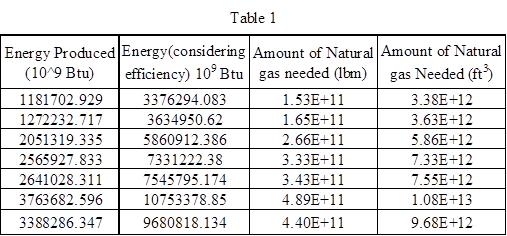
Concept explainers
Find the amount of natural gas required in
Answer to Problem 19P
The amount of natural gas required in
Explanation of Solution
Given data:
Refer to problem 13-19 accompanying table in the textbook.
The average efficiency of the power plant is 35%.
The heating value of the natural gas is
Formula used:
Formula to calculate the power plant efficiency is,
Rearrange the equation,
Convert Btu to
Convert
The value of the
Convert 1 hr into seconds,
Rearrange the equation,
Substitute equation (5) in equation (4),
Rearrange the equation,
Calculation:
Converting the given data from kWh to Btu:
Substitute
Substitute
Substitute
Substitute
Substitute
Substitute
Substitute
Now find the energy input fuel for each year in Btu for natural gas:
Substitute
Substitute
Substitute
Substitute
Substitute
Substitute
Substitute
Now convert Btu to lbm as follows by using the relation
Substitute
Substitute
Substitute
Substitute
Substitute
Substitute
Substitute
Now convert Form lbm to
Substitute
Substitute
Substitute
Substitute
Substitute
Substitute
Substitute
Therefore, the amount of natural gas in

Conclusion:
Hence, the amount of natural gas in
Want to see more full solutions like this?
Chapter 13 Solutions
MindTap Engineering, 2 terms (12 months) Printed Access Card for Moaveni's Engineering Fundamentals, SI Edition, 5th
- Determine the bending moment at support A for the beam shown using the slope-deflection method. Use the sign convention defined in the chapter. a. 232.9 k-ft b. -182.1 k-ft c. 182.1 k-ft d. -232.9 k-ftarrow_forwardWhat is the shear and normal stresses of Point J and Point K?arrow_forwardWhat are the states of stress (magnitude and tension/compression of the normal stresses and shear stress) at Point J and Point K?arrow_forward
- Consider, M people (aka pax) who want to travel by car from O to D. They all start working at D at Q (e.g., Q-8am). If a person departs at time t, assume the time needed to go from O to D is given by c(t)=A+Bx(t), where x(t) is the flow of people departing at time t [car/unit of time]. In addition, a is the penalty for being early at work (E(t) is how early the person arrived when departing at time t), and ẞ is the penalty for being late at work (L(t) is how late the person arrived when departing at time t). Assume 0 < a < 1 < ß. Further assume the departure time choice problem under the equilibrium conditions. Prove that the arrival time of people who depart when most of the M people start their trips is equal to Q.arrow_forwarda. A b. A 3. Sketch normal depth, critical depth and the water surface profile. Assume at A and B the water is flowing at normal depth. Label and Identify all curves (i.e., M1, S2, etc.) Yn > Ye Уп Ye Уп> Ус yarrow_forward2. Design a trapezoidal ditch to carry Q = 1000 cfs. The ditch will be a lined channel, gravel bottom with sides shown below on a slope of S = 0.009. The side slopes of the 20-ft wide ditch will be 1 vertical to 3 horizontal. a) Determine the normal depth of flow (yn) using the Normal value for Manning's n. b) If freeboard requirements are 25% of the normal depth, how deep should the ditch be constructed? c) Classify the slope. T b Уп Z 1 Yn + FBarrow_forwardP15.45 WP A stainless steel pipe (Figure P15.45) with an outside diameter of 2.375 in. and a wall thickness of 0.109 in. is subjected to a bending moment M = 50 lb ft and an internal pressure of 180 psi. Determine the absolute maximum shear stress on the outer surface of the pipe. M FIGURE P15.45 Marrow_forward10.72 What power must the pump supply to the system to pump the oil from the lower reservoir to the upper reservoir at a rate of 0.3 m³/s? Sketch the HGL and the EGL for the system. p=940 kg/m³ v = 10-5 m²/s Elevation 100 m Elevation 112 m L= 150 m Oil Steel pipe D = 30 cm Problem 10.72arrow_forwardL / 83° 28° $75°E M 202° Q2: The scanning process was completed from point J to point N. The direction of the straight line was LM and the angles of deviation are shown in the figure below. Find the direction of the remaining sides? Narrow_forwardarrow_back_iosSEE MORE QUESTIONSarrow_forward_ios
 Engineering Fundamentals: An Introduction to Engi...Civil EngineeringISBN:9781305084766Author:Saeed MoaveniPublisher:Cengage Learning
Engineering Fundamentals: An Introduction to Engi...Civil EngineeringISBN:9781305084766Author:Saeed MoaveniPublisher:Cengage Learning
 Sustainable EnergyCivil EngineeringISBN:9781133108689Author:Richard A. DunlapPublisher:Cengage Learning
Sustainable EnergyCivil EngineeringISBN:9781133108689Author:Richard A. DunlapPublisher:Cengage Learning


